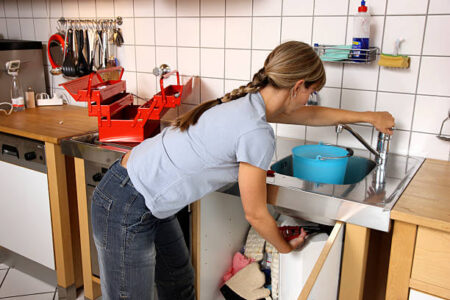A blocked kitchen gully drain can be a major inconvenience, leading to unpleasant odors, slow-draining water, and potential health hazards. This article will provide you with a detailed guide on how to identify, prevent, and unblock a kitchen gully drain efficiently.
What is a Kitchen Gully Drain?
A kitchen gully drain is an outdoor drainage system designed to collect water from kitchen sinks and other kitchen-related wastewater sources. It typically connects to the main sewer line, ensuring that wastewater is directed away from your home. However, these drains can become blocked due to a variety of reasons, including the buildup of grease, food particles, and other debris.
Common Causes of Blocked Kitchen Gully Drains
- Grease and Fat: Pouring grease and fat down the sink can cause it to solidify and accumulate in the drain, leading to blockages.
- Food Waste: Small food particles and scraps can get washed down the sink, gradually accumulating and causing blockages.
- Foreign Objects: Non-biodegradable items like plastic wrappers, straws, and other debris can obstruct the drain.
- Leaves and Outdoor Debris: Leaves, dirt, and other outdoor debris can enter the gully drain, particularly during heavy rains or windy weather.
Signs of a Blocked Kitchen Gully Drain
- Slow Draining Water: If water is taking longer than usual to drain from your sink, it could indicate a blockage.
- Unpleasant Odors: Foul smells coming from your drains or outside near the gully can be a sign of a blockage.
- Water Backup: Water backing up into your sink or other areas is a clear indication of a blocked drain.
- Gurgling Sounds: Unusual gurgling noises from your drains suggest trapped air due to a blockage.
How to Unblock a Kitchen Gully Drain?
- Boiling Water
- Pour boiling water down the drain to dissolve grease and fat buildup.
- Repeat this process several times if necessary.
- Plunger
- Use a plunger to create suction and dislodge the blockage.
- Ensure there is enough water in the sink to cover the plunger cup, and plunge vigorously.
- Drain Snake or Auger
- Insert a drain snake or auger into the drain to break up and remove the blockage.
- Rotate the snake or auger while pushing it through the drain to effectively clear the blockage.
- Baking Soda and Vinegar
- Pour a cup of baking soda followed by a cup of vinegar down the drain.
- Let the mixture sit for 30 minutes to an hour, then flush with hot water.
- Chemical Drain Cleaners
- Use a chemical drain cleaner as a last resort, following the manufacturer’s instructions.
- Be cautious with chemical cleaners as they can be harmful to pipes and the environment.
- Professional Help
- If the blockage persists, it’s best to call a professional plumber.
- Professionals have specialized tools and expertise to handle severe blockages.
What is a Gully Trap for Kitchen Waste?
A gully trap is a plumbing device installed to prevent foul odors, gases, and vermin from entering a building through the drainage system. Specifically for kitchen waste, a gully trap serves to:
- Separate Solids from Liquids: It captures solid waste particles from the kitchen sink, preventing them from entering the main drainage system and causing blockages.
- Prevent Backflow: It ensures that wastewater flows in one direction and prevents backflow into the kitchen.
- Maintain Hygiene: By trapping and holding waste temporarily, it helps maintain a more hygienic environment around the kitchen area.
- Odor Prevention: The water seal in the gully trap acts as a barrier, preventing foul odors from the drainage system from entering the kitchen.
In essence, a gully trap for kitchen waste is a critical component in modern plumbing systems, enhancing the functionality and hygiene of kitchen drainage.
Preventing Future Blockages
- Avoid Pouring Grease and Fat Down the Drain
- Dispose of grease and fat in a container and throw it in the trash.
- Use a Sink Strainer
- Install a sink strainer to catch food particles and prevent them from entering the drain.
- Regular Cleaning
- Regularly clean your drains with boiling water or a baking soda and vinegar solution to prevent buildup.
- Proper Waste Disposal
- Dispose of food waste properly by composting or throwing it in the trash.
- Check Outdoor Drains
- Keep the area around your outdoor gully drain clear of leaves and debris.
Why is My Gully Not Draining?
A gully that is not draining properly can be a frustrating and inconvenient issue. There are several potential reasons for this problem, each requiring different solutions. Here’s a comprehensive look at the common causes and how you can address them.
Common Causes of a Non-Draining Gully
- Blockages
- Debris Accumulation: Leaves, dirt, and other debris can enter the gully and cause a blockage. This is particularly common during autumn or after heavy rains.
- Grease and Fat: Pouring grease and fat down the kitchen sink can lead to solidification and buildup in the gully, obstructing the flow of water.
- Food Particles: Small food particles can accumulate over time and block the drain.
- Structural Issues
- Pipe Damage: Cracked or damaged pipes can restrict water flow. This might be due to age, ground movement, or external pressure.
- Misalignment: Pipes that are not properly aligned can cause water to pool and not drain away efficiently.
- Tree Roots
- Tree roots can invade underground pipes in search of water, causing blockages and even pipe damage.
- Poor Installation
- Incorrect installation of the gully or the drainage system can lead to persistent drainage issues.
- Sewer Line Problems
- A blockage or issue in the main sewer line can cause water to back up into the gully.
Conclusion!!
A blocked kitchen gully drain can be a frustrating problem, but with the right approach, it can be resolved efficiently. By understanding the common causes, recognizing the signs, and following the steps outlined in this guide, you can keep your kitchen gully drain clear and functioning properly. Regular maintenance and preventive measures will help ensure that your drains remain free of blockages, saving you time and hassle in the long run.


